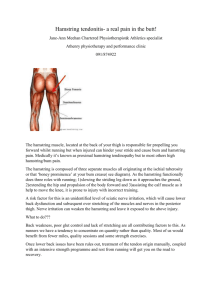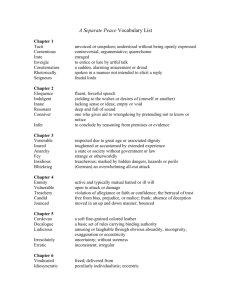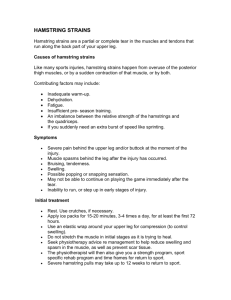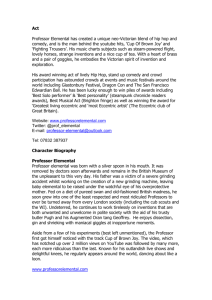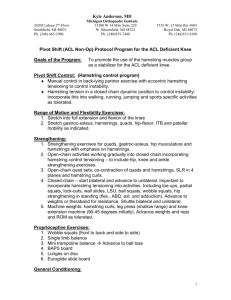The American Journal of Sports Medicine
advertisement
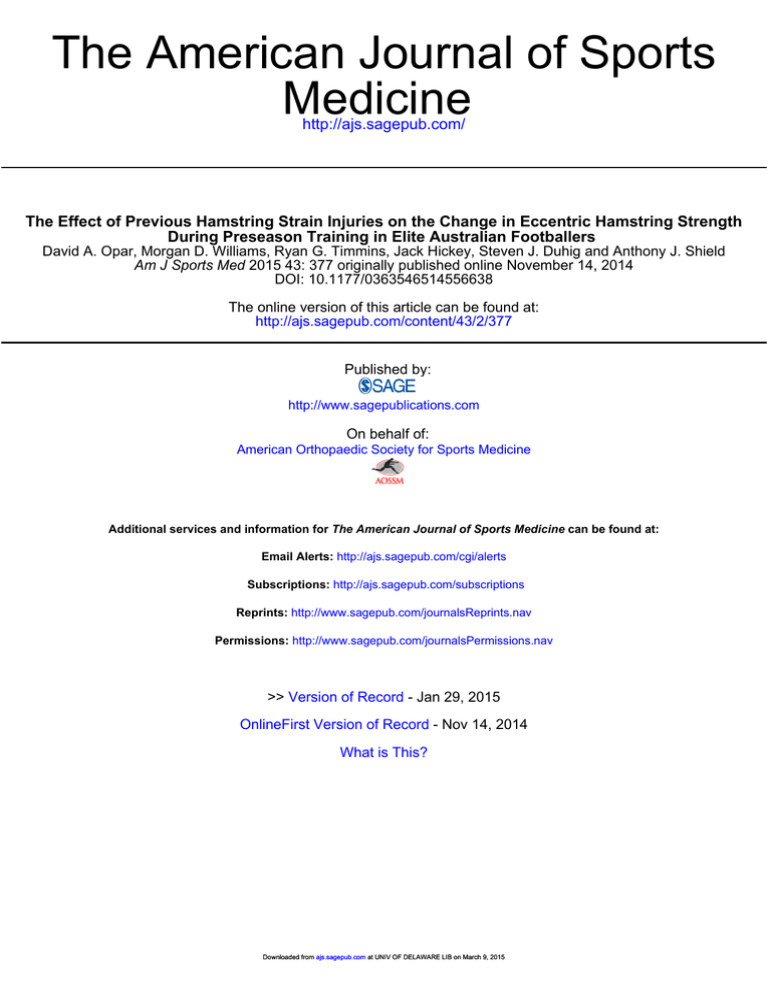
The American Journal of Sports
Medicine
http://ajs.sagepub.com/
The Effect of Previous Hamstring Strain Injuries on the Change in Eccentric Hamstring Strength
During Preseason Training in Elite Australian Footballers
David A. Opar, Morgan D. Williams, Ryan G. Timmins, Jack Hickey, Steven J. Duhig and Anthony J. Shield
Am J Sports Med 2015 43: 377 originally published online November 14, 2014
DOI: 10.1177/0363546514556638
The online version of this article can be found at:
http://ajs.sagepub.com/content/43/2/377
Published by:
http://www.sagepublications.com
On behalf of:
American Orthopaedic Society for Sports Medicine
Additional services and information for The American Journal of Sports Medicine can be found at:
Email Alerts: http://ajs.sagepub.com/cgi/alerts
Subscriptions: http://ajs.sagepub.com/subscriptions
Reprints: http://www.sagepub.com/journalsReprints.nav
Permissions: http://www.sagepub.com/journalsPermissions.nav
>> Version of Record - Jan 29, 2015
OnlineFirst Version of Record - Nov 14, 2014
What is This?
Downloaded from ajs.sagepub.com at UNIV OF DELAWARE LIB on March 9, 2015
The Effect of Previous Hamstring Strain
Injuries on the Change in Eccentric
Hamstring Strength During Preseason
Training in Elite Australian Footballers
5-in-5
David A. Opar,*y PhD, Morgan D. Williams,z PhD, Ryan G. Timmins,y
Jack Hickey,§ Steven J. Duhig,|| and Anthony J. Shield,||{ PhD
Investigation performed at the Queensland University of Technology,
Brisbane, Queensland, Australia
Background: Hamstring strain injuries (HSIs) are the most common injury type in Australian football, and the rate of recurrence
has been consistently high for a number of years. Long-lasting neuromuscular inhibition has been noted in previously injured athletes, but it is not known if this influences the athlete’s adaptive response to training.
Purpose: To determine if elite Australian footballers with a prior unilateral HSI (previously injured group) display less improvement
in eccentric hamstring strength during preseason training compared with athletes without a history of HSIs (control group).
Study Design: Cohort study; Level of evidence, 2.
Methods: A total of 99 elite Australian footballers (17 with a history of unilateral HSIs in the previous 12-month period) participated
in this study. Eccentric hamstring strength was assessed at the start and end of preseason training using an instrumented Nordic
hamstring device. The change in eccentric strength across the preseason was determined in absolute terms and normalized to
the start of preseason strength. The start of preseason strength was used as a covariate to control for differences in starting
strength.
Results: The left and right limbs in the control group showed no difference in absolute or relative change (left limb: 60.7 6 72.9 N
and 1.28 6 0.34 N, respectively; right limb: 48.6 6 83.8 N and 1.24 6 0.43 N, respectively). Similarly, the injured and uninjured
limbs in the previously injured group showed no difference in either absolute or relative change (injured limb: 13.1 6 57.7 N and
1.07 6 0.18 N, respectively; uninjured limb: 14.7 6 54.0 N and 1.07 6 0.22 N, respectively). The previously injured group displayed significantly less increase in eccentric hamstring strength across the preseason (absolute change, 13.9 6 55.0 N; relative
change, 1.07 6 0.20 N) compared with the control group (absolute change, 54.6 6 78.5 N; relative change, 1.26 6 0.39 N) for both
absolute and relative measures (P \ .001), even after controlling for differences in the start of preseason eccentric hamstring
strength, which had a significant effect on strength improvement.
Conclusion: Elite Australian footballers with a unilateral history of HSIs displayed less improvement in eccentric hamstring
strength across preseason training. The smaller improvements were not restricted to the previously injured limb as the contralateral limb also displayed similarly small improvements in eccentric strength. Whether this is the cause of or the result of an injury
remains to be seen, but it has the potential to contribute to the risk of hamstring strain reinjuries.
Keywords: hamstring; muscle injury; eccentric strength; Nordic hamstring exercise
Australian football, much like other sports,1,8 the history
of HSIs is repeatedly identified as the primary risk factor
for future injuries6,25 and is often considered a nonmodifiable risk factor (ie, it cannot be changed).14 However,
a growing body of evidence indicates that neuromuscular
maladaptations associated with previous HSIs may be
responsible for the elevated risk of future injuries, despite
returning to play and ‘‘successful’’ rehabilitation.15,16,21,22
Most notably, hamstring muscles that have previously sustained a strain injury display signs of neuromuscular inhibition during eccentric contractions when compared with
contralateral, uninjured hamstring muscles.15,16,22 The
Over the past 20 seasons, hamstring strain injuries (HSIs)
have been the most prevalent injuries in Australian football,18 and they impose a significant financial burden on
athletes and their associated clubs.9 While the rate of
recurrent HSIs in the elite Australian Football League
has fallen in recent years,17 it still remains one of the
most common types of injury for recurrence.18 In
The American Journal of Sports Medicine, Vol. 43, No. 2
DOI: 10.1177/0363546514556638
Ó 2014 The Author(s)
377
Downloaded from ajs.sagepub.com at UNIV OF DELAWARE LIB on March 9, 2015
378
Opar et al
The American Journal of Sports Medicine
resultant deficits in eccentric knee flexor strength might
reasonably be expected to increase the likelihood of future
HSIs in this limb, given that lower levels of eccentric hamstring strength increase the risk of future injuries.4,23
A recent review5 proposed a novel framework, suggesting that persistent neuromuscular inhibition during eccentric contraction after an HSI15,16,22 could lead to continued
eccentric weakness and thus an elevated risk of reinjuries.14 Based on the proposed framework, it would be
expected that this inhibition has the potential to limit
the extent of muscular adaptations in response to rehabilitative and prophylactic exercises, given the need for high
levels of activation to drive adaptation.5,14 If this were the
case, athletes with a previous HSI might not only show deficits in eccentric hamstring strength in the previously
injured limb but may also show a suppressed response to
eccentric training interventions that are commonly utilized in prophylactic programs. The effect of a prior HSI
on the adaptive capacity of a previously injured athlete
is, however, yet to be examined.
In the elite Australian Football League, the preseason
training period spans up to 4 months between November
and February.24 It is a time in the training cycle when
teams focus on increasing physical fitness with an aim to
improve performance and avoid injuries.24 From the perspective of preventing HSIs, it is common to target gains
in eccentric hamstring strength as one of the major outcomes during the preseason period. Much of this philosophy is based on evidence showing the preventive benefits
of eccentric hamstring strengthening during the preseason
in other sports.2,4,19 There is currently no work that examines the improvements in eccentric hamstring strength
throughout the preseason training period in elite Australian footballers and whether a previous HSI affects the
athlete’s ability to improve eccentric hamstring strength.
The purpose of this investigation was to assess eccentric
hamstring strength changes during the preseason training
period in elite Australian footballers with and without
a history of unilateral HSIs. We hypothesized that athletes
with a history of HSIs would exhibit a minimal increase in
eccentric hamstring strength during the preseason training period compared with uninjured athletes.
MATERIALS AND METHODS
Sample Size Calculations
Based on a previous study,22 which used a similar research
design, an a priori sample size of 15 for the previously
injured group and 75 for the control group was determined
using G*Power (v 3.1.7). The input parameters for the
power analysis were the following: independent t test,
effect size (d) = 0.8, a = .05, b = .20, and allocation ratio
of 5:1. An independent t test was selected because the
change in eccentric hamstring strength for both limbs
was expected to be averaged and then compared between
groups, as performed previously,22 given that the adaptive
capacity would be centrally impaired and not limb specific.5 A large effect size was anticipated based on Rhea
et al,20 and the 5:1 sample ratio was based on typical hamstring injury rates of 15% to 20%.14
Participants
A total of 99 Australian footballers from 5 elite teams were
eligible to participate (from an overall pool of 210) in the
study, of whom 17 had a history of unilateral HSIs (previously injured group), confirmed by magnetic resonance
imaging (MRI), in the previous 12-month period. All participants were free of injuries to the lower limbs (able to participate fully in training), which would be expected to
influence knee flexor strength at the time of testing. Exclusion criteria included any athlete with a history of bilateral
HSIs in the prior 12 months, any athlete with a history of
clinically diagnosed HSIs that were negative on MRI scans
in the prior 12 months, any athlete who sustained an HSI
during the preseason, and any athlete who had sustained
an anterior cruciate ligament rupture previously or who
had sustained an injury to the quadriceps, calf, or groin/
hip in the prior 12 months. All testing procedures were
approved by the university’s human research ethics committee, and participants gave informed written consent
before testing after having all procedures explained to
them.
Experimental Design
The current study employed a prospective cohort design.
All athletes reported for testing during the first and final
weeks of preseason training (November-February). On
each occasion, all athletes completed a submaximal
warm-up set of the Nordic hamstring exercise, followed
by a single set of 3 maximal repetitions of the Nordic hamstring exercise, during which eccentric knee flexor forces of
the left and right limbs were recorded using a custommade device. All testing was performed after similar levels
(duration and intensity) of training completed in the days
previously.
*Address correspondence to David A. Opar, PhD, School of Exercise Science, Australian Catholic University, 17 Young Street, Fitzroy, VIC, 3065, Australia (e-mail: david.opar@acu.edu.au).
y
School of Exercise Science, Australian Catholic University, Melbourne, Victoria, Australia.
z
Faculty of Health, Sport and Science, University of South Wales, Pontypridd, Wales, UK.
§
MD Health Pilates, Melbourne, Victoria, Australia.
||
School of Exercise and Nutrition Science, Queensland University of Technology, Brisbane, Queensland, Australia.
{
Institute of Health and Biomedical Innovation, Queensland University of Technology, Brisbane, Queensland, Australia.
One or more of the authors has declared the following potential conflict of interest or source of funding: D.A.O. and A.J.S. are listed as co-inventors on
a patent application for the eccentric hamstring field testing device used in the current study. Funding was provided by Qutbluebox (http://www.qutblue
box.com.au/), the innovation and technology transfer affiliate of the Queensland University of Technology. Funding was provided to assist with the completion of the study and to cover costs associated with filing the patient application for the hamstring field testing device.
Downloaded from ajs.sagepub.com at UNIV OF DELAWARE LIB on March 9, 2015
Vol. 43, No. 2, 2015
Eccentric Hamstring Strength in the AFL 379
Figure 1. Performing the Nordic hamstring exercise using the novel device (progressing from left to right). The participant controls the speed of the fall by forceful eccentric contraction of the knee flexors. After completion of the exercise, the participant
slowly returns to the starting position by pushing back up with both hands (not shown). The ankles are secured independently
in individual custom-made braces.
Eccentric Knee Flexor Strength Assessment
The device used to determine eccentric knee flexor strength
during the Nordic hamstring exercise and its reliability
have been described previously and can be seen in Figures
1 and 2.13 Participants knelt on a padded board, with the
ankles secured immediately superior to the lateral malleolus
by individual ankle braces that were attached to custommade uniaxial load cells (Delphi Force Measurement) with
wireless data acquisition capabilities (Mantracourt). The
ankle braces and load cells were secured to a pivot, which
allowed the force to always be measured through the long
axis of the load cells, with an individual load cell for both
the left and right limbs, allowing for separate measurements
from each limb. After a warm-up set, participants performed
1 set of 3 maximal repetitions of the bilateral Nordic hamstring exercise. Instructions to players were to gradually
lean forward at the slowest possible speed while maximally
resisting this movement with both limbs, while keeping the
trunk and hips held in a neutral position throughout and
the hands held across the chest.13 Participants were loudly
exhorted to provide maximal effort throughout each repetition. A trial was deemed acceptable when the force output
reached a distinct peak (indicative of maximal eccentric
strength), followed by a rapid decline in force that occurred
when the athlete was no longer able to resist the effects of
gravity acting on the segment above the knee joint.
History of Injuries
For all athletes recruited who had sustained a unilateral
HSI in the 12 months before the first testing session,
details of their history of injuries were obtained from their
club clinician. Details obtained included which limb was
injured (dominant/nondominant limb), muscle injured
(long head of the biceps femoris/short head of the biceps
femoris/semimembranosus/semitendinosus), location of
injury (proximal/distal, muscle belly/muscle-tendon junction), activity type performed at the time of injury
(running/kicking, etc), and grade of injury (I, II, or III).
Importantly, all diagnoses were confirmed by MRI performed 48 to 72 hours after the insult.
Figure 2. Close-up view of the ankle brace and load cell
organization with the participant’s limb in position during
the Nordic hamstring exercise.
Preseason Training Programs
With regard to prophylactic programs for the prevention of
HSIs, all clubs utilized the Nordic hamstring exercise and
stiff-legged (or Romanian) deadlift as part of their training
regimen. Typical set and repetition ranges for the Nordic
hamstring exercise were 2 to 4 sets with 6 to 10 repetitions.
These prophylactic exercises were completed at least on
a weekly basis by all teams included in the study. In addition,
there was a strong focus on exercises that aimed to increase
eccentric hamstring strength using a combination of bilateral
and unilateral movements. Often, athletes with a history of
HSIs were prescribed additional eccentric exercises as part
of the effort to further reduce their risk of reinjuries.
Data Analysis
Force data for both limbs during the Nordic hamstring exercise were logged into a personal computer at 100 Hz through
a wireless USB base station receiver (Mantracourt). For
both limbs (left/right for the control group or injured/
uninjured for the previously injured group), peak force for
each contraction was determined, and maximal force-
Downloaded from ajs.sagepub.com at UNIV OF DELAWARE LIB on March 9, 2015
380
Opar et al
The American Journal of Sports Medicine
TABLE 1
Details of Prior Hamstring Strain Injuries Sustained by Athletes in the Injured Groupa
Participant
1
2
3
4
5
6
7
8
9
10
11
12
13
14
15
16
17
Limb
Injured
Muscle
Injured
Location
of Injury
Activity at
Time of Injury
Rehabilitation Time for
Most Recent Injury, d
Time Between Most Recent Injury
and First Strength Testing Session, wk
D
D
D
ND
ND
ND
D
D
D
D
ND
ND
ND
ND
D
ND
D
SM
BFlh
BFlh
ST
BFlh
SM
ST
BFlh
BFlh
BFlh
BFlh
BFlh
BFlh
BFlh
BFlh
BFlh
BFlh
Proximal MTJ
Distal MTJ
Proximal MTJ
Muscle belly
Proximal MTJ
Proximal tendon
Distal MTJ
Proximal MTJ
Muscle belly
Muscle belly
Muscle belly
Proximal MTJ
Proximal MTJ
Distal MTJ
Proximal MTJ
Proximal MTJ
Proximal MTJ
Running
Running
Kicking
Running
Running
Bending forward
Running
Running
Running/kicking
Running
Not defined
Running
Running
Running
Bending forward
Running
Running
62
31
76
25
19
79
21
72
32
23
26
33
60
23
35
21
19
14
17
31
24
9
30
52
32
15
40
25
35
16
19
6
12
13
a
BFlh, long head of the biceps femoris; D, dominant; MTJ, muscle-tendon junction; ND, nondominant; SM, semimembranosus; ST,
semitendinosus.
generating capacity was expressed as the mean of the peak
from 3 contractions (mean peak force). This method of analysis was chosen because it has displayed high test-retest
reliability (intraclass correlation coefficient, 0.85-0.89).13
The change in eccentric strength across the preseason was
expressed in absolute units (newtons) as well as relative
to the early preseason strength measure by taking the quotient of late preseason and early preseason strength.
Statistical Analysis
Data were screened, and all test assumptions were
assessed to confirm the appropriateness of the analyses.
The change in eccentric hamstring strength across the preseason was compared between the left and right limbs of
the control group and between the retrospectively injured
and uninjured limbs in the previously injured group using
a 2-tailed paired-samples t test. As no within-group differences were noted, the 2 limbs for each group were averaged. To compare between the control and previously
injured groups, a univariate general linear model was
employed, with eccentric knee flexor strength at the start
of the preseason used as a covariate, to control for differences in baseline strength because it was different between
groups. Statistical significance was set at P \ .05 and the
Cohen d used to assess the magnitude of the effect. Data
are reported as mean differences 6 SD or, if stated, 95%
CI. All statistical analyses and assumption testing were
performed using SPSS v 19.0.0.1 (IBM Corp).
RESULTS
Of the 17 athletes with a history of unilateral HSIs in the
prior 12 months, the injuries were distributed accordingly:
dominant limb (53%), long head of the biceps femoris
(76%), and the proximal muscle-tendon junction (53%)
(Table 1). Time since the most recent HSI ranged from
1.5 to 12 months (median time since injury, 4.4 months/
19 weeks), with the rehabilitation time ranging from 19
to 79 days (median rehabilitation time, 31 days). The distribution of these 17 athletes at each of the 5 participating
clubs was 5, 4, 4, 3, and 1, respectively. All athletes (and
associated medical staff) reported a strong emphasis on
eccentric conditioning and high-speed running during
late-stage rehabilitation and in the lead-up to return to
play.
Descriptive statistics for both groups with respect to
demographic data and absolute levels of eccentric hamstring strength at the start and end of the preseason can
be found in Table 2. While the previously injured athletes
presented with generally higher levels of eccentric
strength compared with athletes in the control group, the
only significant difference was that the left limb in athletes
in the control group was weaker than the uninjured limb in
athletes with a previously injured limb (P = .020). With
respect to the change in eccentric hamstring strength
across the preseason, the left and right limbs of athletes
in the control group showed no difference in either absolute
or relative measures of change (left limb: 60.7 6 72.9 N and
1.28 6 0.34 N, respectively; right limb: 48.6 6 83.8 N and
1.24 6 0.43 N, respectively) (Table 3). Similarly, the
injured and uninjured limbs of athletes in the previously
injured group showed no difference in either absolute or
relative measures of change (injured limb: 13.1 6 57.7 N
and 1.07 6 0.18 N, respectively; uninjured limb: 14.7 6
54.0 N and 1.07 6 0.22 N, respectively) (Table 3).
Given that there were no differences in the change in
eccentric hamstring strength between the left and right
limbs of athletes in the control group (left vs right: absolute
Downloaded from ajs.sagepub.com at UNIV OF DELAWARE LIB on March 9, 2015
Vol. 43, No. 2, 2015
Eccentric Hamstring Strength in the AFL 381
TABLE 2
Demographic and Eccentric Knee Flexor
Strength Data for All Athletes
Variable
Uninjured group (n = 82)
Age, y
Height, cm
Weight, kg
Early preseason eccentric strength, N
Left limb
Right limb
Late preseason eccentric strength, N
Left limb
Right limb
Previously injured group (n = 17)
Age, y
Height, cm
Weight, kg
Early preseason eccentric strength, N
Injured limb
Uninjured limb
Late preseason eccentric strength, N
Injured limb
Uninjured limb
Mean 6 SD
22.6 6 3.3
188.3 6 7.6
87.8 6 7.6
271.9 6 74.8
290.8 6 84.4
327.7 6 73.5
336.9 6 71.0
23.3 6 2.6
186.2 6 6.5
85.9 6 6.6
297.9 6 89.6
310.9 6 82.7
311.0 6 82.6
325.6 6 82.0
change, P = .06, d = 0.15; relative change, P = .291, d =
0.10), the results of the 2 limbs were averaged to give
a mean control group change in eccentric hamstring
strength. Similarly, for the previously injured group, as
there was no difference between limbs (injured vs uninjured: absolute change, P = .88, d = 0.03; relative change,
P = .934, d = 0.00), the results of the injured and uninjured
limbs were also averaged to give a mean injured group
change in eccentric hamstring strength. Athletes in the
previously injured group displayed a significantly smaller
increase in eccentric hamstring strength across the preseason (absolute change, 13.9 6 55.0 N; relative change,
1.07 6 0.20 N) compared with those in the control group
(absolute change, 54.6 6 78.5 N; relative change, 1.26 6
0.39 N) for both absolute and relative measures, even after
controlling for differences in the start of preseason eccentric hamstring strength. The start of preseason eccentric
hamstring strength had a significant effect (P \ .001) on
both absolute and relative strength changes (Table 4).
DISCUSSION
The present study aimed to determine if elite Australian footballers with a history of unilateral HSIs (within the prior 12
months) would display a smaller increase in eccentric hamstring strength across the preseason training period compared with athletes without a history of HSIs. The major
finding was that the previously injured athletes displayed
smaller increases in eccentric hamstring strength compared
with the control group athletes, who had no history of HSIs
in the prior 12 months. Interestingly, the smaller increase
in eccentric strength across the preseason was not restricted
to the previously injured limb, as increases between injured
and uninjured limb strength did not differ.
This study is, to our knowledge, the first to examine the
change in eccentric hamstring strength across the preseason training period in elite Australian footballers. One
study, a randomized controlled trial (RCT) in elite Swedish
soccer players, examined the effect of augmented eccentric
training, via a flywheel ergometer, for the hamstrings
across 10 weeks of preseason training and reported an
approximately 19% increase in eccentric hamstring torque.2 The improvements in the control group in the present
study are similar in magnitude (15%-20%) to those
reported by Askling et al2 in the training arm of their trial;
however, the effect of previous HSIs on eccentric strength
improvements was not examined.
The finding that athletes with a history of HSIs displayed a smaller increase in eccentric strength during
the preseason might have implications for recurrent injuries. Given the retrospective nature of these observations,
it is impossible to determine whether a smaller increase in
eccentric strength is the result of injury and/or a predisposing factor that leads to the initial insult. It is also possible
that a heavy focus on eccentric exercise during the late
stage of rehabilitation could influence the change in eccentric hamstring strength during the subsequent preseason
training period. Regardless, given the established link
between prior HSIs and the increased risk of future injuries in elite Australian football,6,25 characteristics of previously injured athletes can help to identify variables that
warrant further investigation. Of interest from the current
data set is the possibility that athletes display variable
increases in eccentric hamstring strength (ie, high and
low responders) across preseason training. As eccentric
strengthening interventions2,19 and smaller between-limb
eccentric strength imbalances23 appear to reduce the risk
of HSIs, players with a reduced ability to increase eccentric
hamstring strength might be predisposed to a greater likelihood of future HSIs. Further work should consider the
implementation of a standard eccentric hamstring
strengthening intervention across a large participant pool
to determine the spectrum of strength increases, with
these participants followed prospectively to establish if
there is a causative relationship with HSIs.
It should also be acknowledged that rehabilitation processes would likely play a critical role in the recovery of
eccentric strength after an HSI and might also influence
the adaptive response to eccentric exercise. It would be of
interest to examine increases in eccentric strength and
adaptive capacity in previously injured athletes who are
exposed to standardized rehabilitation protocols, such as
those reported previously.3 It is also intriguing that the
injured athletes displayed smaller increases in eccentric
strength across the preseason but that there was no difference noted between the injured and uninjured limbs within
this group. This raises the possibility that persistent neuromuscular inhibition noted during eccentric contractions
after unilateral HSIs15,16,22 may be mediated by central
mechanisms and as such have bilateral effects. Furthermore, it is possible that differences between the injured
and control groups with respect to eccentric hamstring
strength at the start of the preseason (ie, baseline
strength) may have affected the improvements seen in
Downloaded from ajs.sagepub.com at UNIV OF DELAWARE LIB on March 9, 2015
382
Opar et al
The American Journal of Sports Medicine
TABLE 3
Absolute and Relative Change in Eccentric Knee Flexor Strength Between Limbs
Group
Relative Change in
Effect Eccentric Strength,
Mean 6 SD,b N
P Value Sizea
Absolute Change in
Eccentric Strength,
Mean 6 SD, N
Between-Limb
Difference
(95% CI), N
14.7 6 54.0
13.1 6 57.7
1.6 (–37.4 to 40.6)
.88
0.03
60.7 6 72.9
48.6 6 83.8
12.1 (–12.1 to 36.3)
.06
0.15
Previously injured
group (n = 17)
Uninjured limb
Injured limb
Uninjured group
(n = 82)
Left limb
Right limb
Between-Limb
Difference
(95% CI), N
P Value
Effect
Sizea
1.07 6 0.22
1.07 6 0.18
0.00 (–0.14 to 0.14)
.934
0.00
1.28 6 0.34
1.24 6 0.43
0.04 (–0.08 to 0.16)
.291
0.10
a
Cohen d was used to determine the effect size.
Change was determined as the quotient of late over early preseason eccentric hamstring strength.
b
TABLE 4
Absolute and Relative Change in Eccentric Knee Flexor Strength Between Groups
Group
Previously injured
group (n = 17)
Uninjured group
(n = 82)
Covariate effect (early
preseason eccentric
strength)
Relative Change in Between-Group
Absolute Change
Between-Group
in Eccentric Strength,
Difference
Effect Eccentric Strength,
Difference
Effect
Mean 6 SD,b N
Mean 6 SD, N
(95% CI), N
P Value Sizea
(95% CI), N
P Value Sizea
13.9 6 55.0
40.7 (1.0-80.4)
.012c
54.6 6 78.5
0.60
1.07 6 0.20
0.19 (0.0-0.38)
.015c
0.73
1.26 6 0.39
\.001d
\.001d
a
Cohen d was used to determine the effect size.
Change was determined as the quotient of late over early preseason eccentric hamstring strength.
c
Significance was set at P \ .05, with the start of preseason eccentric strength employed as a covariate in a general linear model.
d
Early preseason strength had a significant effect as a covariate.
b
strength across the preseason. It might be argued that the
higher starting strength in the injured group would limit
the scope for improvement across the preseason; however,
ongoing subsequent work from our group suggests that
approximately 340 N is not close to the maximal strength
capacity of most elite Australian footballers, with scores
well in excess of 400 N noted in well-trained athletes.
When the start of preseason eccentric strength was controlled for as a covariate in the analysis, differences
between the groups still persisted. It should also be noted
that when examining the increase in eccentric hamstring
strength in athletes from both groups in the bottom quartile for eccentric strength at the start of the preseason, athletes in the control group (mean start of preseason
strength, 195 N) displayed an approximately 55% increase
in eccentric strength while those in the previously injured
group (mean start of preseason strength, 194 N) increased
approximately 20%.
The limitation of eccentric hamstring strength gains in
the athlete with a previous HSI, as reported in the current
study, is intriguing as a large RCT has shown that the
implementation of the Nordic hamstring exercise during
the preseason in soccer players resulted in a significant
reduction in the rate of reinjuries.19 It would be reasonable
to posit that the significant reduction in reinjuries was conferred by an increase in eccentric hamstring strength after
the Nordic hamstring exercise intervention.12 The results
from the current study suggest that eccentric strength
improvements may have been restricted in the previously
injured athletes; however, the cohort from the RCT19 consisted of soccer players without a history of eccentric training of the hamstrings before the intervention. This differs
significantly from the cohort of elite Australian footballers
who employ targeted eccentric exercise as part of the late
stages of rehabilitation and return to play and generally
for the prevention of HSIs. It remains to be seen if greater
magnitudes of, or larger improvements in, eccentric hamstring strength, assessed during the performance of the
Nordic hamstring exercise, reduce the risk of future HSIs.
Besides a history of unilateral HSIs, other factors may
be responsible for the divergent responses between the 2
groups. First, the strong focus on eccentric exercise during
the late stages of rehabilitation has the potential to influence eccentric strength and the change in strength across
Downloaded from ajs.sagepub.com at UNIV OF DELAWARE LIB on March 9, 2015
Vol. 43, No. 2, 2015
Eccentric Hamstring Strength in the AFL 383
the preseason period. Indeed, the low between-limb
strength imbalance in the previously injured group at the
start of the preseason (1.3%), which was much smaller
than in previous reports using the current strength assessment device (15%),13 is suggestive that rehabilitation in
this cohort aimed to minimize any deficits in eccentric
strength. The influence of rehabilitation procedures, across
the spectrum of HSI severities, on long-lasting deficits in
function and response to training stimuli is an area of
great interest for future investigations. Second, the physiological demands of Australian football require athletes at
the elite level to possess high aerobic and anaerobic fitness,
maximal sprint speeds, repeat sprint performance, and
strength and power qualities.7 These diverse demands
require an intense training load for athletes, particularly
during preseason training. However speculative, it is possible that the multiple physiological demands of preseason
training might minimize improvements in certain performance markers in some athletes.10 If some athletes struggle to improve strength/power qualities (such as eccentric
hamstring strength), then it would be reasonable to suggest that their risk of HSI would be greater.4 It is possible
that the athletes of the previously injured group in the current work had, in prior seasons, improved eccentric hamstring strength minimally because of the competing
demands of preseason training, predisposing them to injuries, and that phenomenon (a low responder to strength
training) was measured here more so than the effect of
prior injuries. The complex interaction of the numerous
factors that can affect strength gains during preseason
training in elite athletes certainly requires greater focus,
particularly given the important role that strength plays
in injury prevention.11
There are some limitations inherent to this study. The
investigators had no control over the preseason training
programs of any team involved (as is to be expected in an
elite sporting environment), as this study was purely
observational. While we were able to report general details
of the preseason HSI prophylactic program, we are not able
to comment as to whether differing training programs
between athletes and/or teams may have influenced the
findings. In spite of this, these observations were made
on 99 athletes across 5 elite Australian football teams, suggesting that the results may be generalizable within this
sport. Furthermore, the history of HSIs was confined to
the previous 12 months to minimize reporting errors, and
this neglects HSIs that occurred before this time period.
Severe HSIs sustained more than 12 months ago may
have confounded the current findings. Importantly, however, all HSIs were confirmed by MRI to eliminate the
inclusion of athletes suffering referred pain from posterior
thigh injuries, and this is a strength of the current investigation.25 Finally, while the study was sufficiently powered
to detect between-group differences, given the relatively
small sample of previously injured athletes, it was underpowered to explore the possible effect of time since injury,
the number and severity of previous HSIs, rehabilitation
type and length, and the possible role of other lower limb
injuries on improvements in eccentric hamstring strength
across the preseason. A larger study examining a more
homogeneous sample of HSIs, powered to include additional covariates, is warranted in the future. A larger sample would also allow for an analysis to control for cluster
effects by team, which was not possible with the current
sample size.
In conclusion, elite Australian footballers with a unilateral history of HSIs within the previous 12 months displayed a greater baseline level of and a smaller increase
in eccentric hamstring strength through the preseason
training period compared with their control group counterparts. Interestingly, this diminished response was not confined to the previously injured limb but was also observed
in the contralateral uninjured limb, which might suggest
that the effects of a prior HSI may be centrally mediated.
The existence of high and low responders to eccentric exercise and the effect on the risk of future HSIs are worthy of
further examination.
REFERENCES
1. Arnason A, Sigurdsson SB, Gudmundsson A, Holme I, Engebretsen
L, Bahr R. Risk factors for injuries in football. Am J Sports Med.
2004;32(1 Suppl):5-16.
2. Askling C, Karlsson J, Thorstensson A. Hamstring injury occurrence
in elite soccer players after preseason strength training with eccentric
overload. Scand J Med Sci Sports. 2003;13(4):244-250.
3. Askling CM, Tengvar M, Thorstensson A. Acute hamstring injuries in
Swedish elite football: a prospective randomised controlled clinical
trial comparing two rehabilitation protocols. Br J Sports Med.
2013;47(15):953-959.
4. Croisier JL, Ganteaume S, Binet J, Genty M, Ferret JM. Strength
imbalances and prevention of hamstring injury in professional soccer
players: a prospective study. Am J Sports Med. 2008;36(8):14691475.
5. Fyfe JJ, Opar DA, Williams MD, Shield AJ. The role of neuromuscular
inhibition in hamstring strain injury recurrence. J Electromyogr Kinesiol. 2013;23(3):523-530.
6. Gabbe BJ, Bennell KL, Finch CF, Wajswelner H, Orchard JW. Predictors of hamstring injury at the elite level of Australian football. Scand J
Med Sci Sports. 2006;16(1):7-13.
7. Gray AJ, Jenkins DG. Match analysis and the physiological demands
of Australian football. Sports Med. 2010;40(4):347-360.
8. Hagglund M, Walden M, Ekstrand J. Previous injury as a risk factor
for injury in elite football: a prospective study over two consecutive
seasons. Br J Sports Med. 2006;40(9):767-772.
9. Hickey J, Shield AJ, Williams MD, Opar DA. The financial cost of
hamstring strain injuries in the Australian Football League. Br J Sports
Med. 2014;48(8):729-730.
10. Hickson RC. Interference of strength development by simultaneously
training for strength and endurance. Eur J Appl Physiol Occup Physiol. 1980;45(2-3):255-263.
11. Lauersen JB, Bertelsen DM, Andersen LB. The effectiveness of exercise interventions to prevent sports injuries: a systematic review and
meta-analysis of randomised controlled trials. Br J Sports Med.
2014;48(11):871-877.
12. Mjolsnes R, Arnason A, Osthagen T, Raastad T, Bahr R. A 10-week
randomized trial comparing eccentric vs. concentric hamstring
strength training in well-trained soccer players. Scand J Med Sci
Sports. 2004;14(5):311-317.
13. Opar DA, Piatkowski T, Williams MD, Shield AJ. A novel device using
the Nordic hamstring exercise to assess eccentric knee flexors
strength: a reliability and retrospective injury study. J Orthop Sports
Phys Ther. 2013;43(9):636-640.
14. Opar DA, Williams MD, Shield AJ. Hamstring strain injuries: factors
that lead to injury and re-injury. Sports Med. 2012;42(3):209-226.
Downloaded from ajs.sagepub.com at UNIV OF DELAWARE LIB on March 9, 2015
384
Opar et al
The American Journal of Sports Medicine
15. Opar DA, Williams MD, Timmins RG, Dear NM, Shield AJ. Knee flexor
strength and bicep femoris electromyographical activity is lower in previously strained hamstrings. J Electromyogr Kinesiol. 2012;23(3):696-703.
16. Opar DA, Williams MD, Timmins RG, Dear NM, Shield AJ. Rate of torque and electromyographic development during anticipated eccentric contraction is lower in previously strained hamstrings. Am J
Sports Med. 2013;41(1):116-125.
17. Orchard J, Seward H. Injury report 2010: Australian Football League.
Sport Health. 2011;29(2):15.
18. Orchard JW, Seward H, Orchard JJ. Results of 2 decades of injury
surveillance and public release of data in the Australian Football
League. Am J Sports Med. 2013;41(4):734-741.
19. Petersen J, Thorborg K, Nielsen MB, Budtz-Jorgensen E, Holmich P.
Preventive effect of eccentric training on acute hamstring injuries in
men’s soccer: a cluster-randomized controlled trial. Am J Sports
Med. 2011;39(11):2296-2303.
20. Rhea MR, Alvar BA, Burkett LN, Ball SD. A meta-analysis to determine the dose response for strength development. Med Sci Sports
Exerc. 2003;35(3):456-464.
21. Silder A, Thelen DG, Heiderscheit BC. Effects of prior hamstring
strain injury on strength, flexibility, and running mechanics. Clin Biomech (Bristol, Avon). 2010;25(7):681-686.
22. Sole G, Milosavljevic S, Nicholson HD, Sullivan SJ. Selective strength
loss and decreased muscle activity in hamstring injury. J Orthop
Sports Phys Ther. 2011;41(5):354-363.
23. Sugiura Y, Saito T, Sakuraba K, Sakuma K, Suzuki E. Strength
deficits identified with concentric action of the hip extensors
and eccentric action of the hamstrings predispose to hamstring
injury in elite sprinters. J Orthop Sports Phys Ther. 2008;38(8):457464.
24. Verrall GM, Slavotinek JP, Barnes PG. The effect of sports specific
training on reducing the incidence of hamstring injuries in professional Australian Rules football players. Br J Sports Med.
2005;39(6):363-368.
25. Verrall GM, Slavotinek JP, Barnes PG, Fon GT, Spriggins AJ. Clinical
risk factors for hamstring muscle strain injury: a prospective study
with correlation of injury by magnetic resonance imaging. Br J Sports
Med. 2001;35(6):435-439.
For reprints and permission queries, please visit SAGE’s Web site at http://www.sagepub.com/journalsPermissions.nav
Downloaded from ajs.sagepub.com at UNIV OF DELAWARE LIB on March 9, 2015

